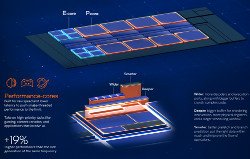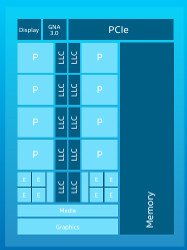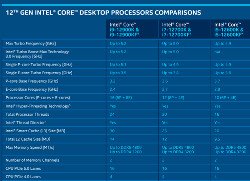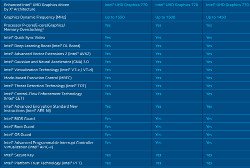12th Gen Alder Lake chips arrive with DDR5, PCIe Gen5, and a Thread Director
Nov 18, 2021 — by Eric Brown 669 views [Updated: Nov. 19] — Intel has launched its first 12th Gen “Alder Lake” CPUs, starting with desktop models led by a 16-core Core i9-12900K. The sub-10GHz CPUs feature a hybrid design that balances load between Performance and Efficient cores.
[Updated: Nov. 19] — Intel has launched its first 12th Gen “Alder Lake” CPUs, starting with desktop models led by a 16-core Core i9-12900K. The sub-10GHz CPUs feature a hybrid design that balances load between Performance and Efficient cores.
Intel opened pre-orders yesterday for its first 12th Gen Alder Lake CPUs. The first six models are aimed primarily at high-end desktops, but there will be more than 60 models, including variants aimed at laptops and edge computing, ranging from 9W configurable TDPs up to the 125W TDPs offered here.
Alder Lake is Intel 10nm Enhanced SuperFin desig called Intel 7. The 12th Gen platform, which adds DDR5 and PCIe Gen5 support, was formally announced on Oct. 27.


12th Gen Core “Alder Lake” P-cores (left) and E-cores
(click images to enlarge)
The 12th Gen CPUs debut a hybrid architecture that can be considered Intel’s answer to Arm’s Big.Little with DynamIQ multi-core orchestration scheme. Alder Lake uses a combination of “Golden Cove” Performance-cores (P-cores), which are billed as “the highest performing CPU core Intel has built,” along with lower power “Gracemount” Efficient-cores (E-cores), which are designed for scalable multi-threaded workload performance.
— ADVERTISEMENT —
Compared to 11th Gen cores, the 12th Gen P-cores offer more decoders and execution ports as well as bigger buffers and more physical registers, says Intel. Prefetch and branch prediction have also been improved.
A new Intel Thread Director technology dynamically allocates loads in real-time to the appropriate cores. Thread Director can dynamically assign individual threads and change the assignments on the fly.


12th Gen Core architecture (left) and Thread Director thread allocation on a typical content creation application
(click images to enlarge)
As seen in chart above showing thread allocation for a content creation application, Thread Director typically assigns the vector-heavy threads (dark blue) to “P-cores” while the scalar (dark green) and background (light blue) are generally assigned to E-cores. Yet, the assignments change as the application progresses, for example with vector threads dropping down to E-cores during heavy scalar processing. In other applications, AI threads are prioritized.
Thread Director relies in part on providing runtime feedback to the OS to provide optimal thread scheduling decisions. As a result of a collaboration with Microsoft (remember Wintel?), Thread Director will initially be available only in Windows 11, with partial support available in Windows 10. Linux support for Thread Director is still in development.
Leading the Alder Lake sixpack is the 16-core, 24-thread Core i9-12900K — Intel’s gaming champion to take on AMD processors such as the Ryzen 5950X. The processor offers 2.3GHz/5.2GHz clock rates on the 8x P-cores and 2.4GHz/3.9GHz on the 8x E-cores. The flagship i9-12900K provides 30MB Intel Smart Cache (L3) and 14MB L2 cache.


First six 12th Gen Core parts and major features
(click images to enlarge)
The i9 parts offer 8x P/8x E configurations with 24 threads while the i7 models offer 8x P/4x E with 20 threads. The i5 models provide 6x P/4x E for 16 threads.
Each of these configurations are available initially in three standard K models (i9, i7, and i5) with Intel UHD Graphics 770. These will be followed by headless KF models in each category that lack the GPU and will require discrete graphics cards via PCIe. Otherwise, the KF models appear to be identical.
Intel UHD Graphics 770 uses the same up to 32-EU Iris Xe architecture offered with its 11th Gen processors such as Rocket Lake and Tiger Lake. The GPU, which advances to Gen 12.2, offers up to 1.55GHz max dynamic frequency compared to 1.3GHz on Intel’s highest-end Core processor to date — the octa-core Core i9-11900K from its recent 11th Gen Rocket Lake-S family. As with Tiger Lake and Rocket Lake, the GPU supports up to 8K HDR video in billions of colors and up to 4x simultaneous 4K displays.
Intel notes that its benchmarks show the 16-core Core i9-12900K delivering about 25 percent higher frames per second than the Rocket Lake i9-11900K on games such as Troy: A Total War Saga. An AnandTech analysis offers its own benchmarks, which reveal that the P-cores are faster than AMD’s Zen3 cores and that the E-cores are faster than Intel’s 7th Gen Skylake cores. Running Win 10, which is not fully optimized for Thread Director, the i9-12900K is roughly on par with Ryzen 9 processors such as the Ryzen 5950X, says AnandTech.


12th Gen Core CPU (left) and feature overview
(click images to enlarge)
As with the 11th Gen chips, 12th Gen Core CPUs offer Intel Deep Learning Boost (DL-Boost) and Intel Advanced Vector Extensions 2 (AVX2) for AI acceleration across CPU and GPU cores. There is also an Intel Gaussian and Neural Accelerator (GNA) 3.0 that works with the GPU. You will also find Intel technologies for enhanced security such as Intel Threat Detection Technology (TDT) and AES-NI (see feature list above).
DDR5, PCIe Gen5, and Wi-Fi 6E
Other Intel benchmarks show improvements based on Alder Lake’s support for up to 128GB 4800 MT/s DDR5 compared to DDR4-3200. Improved overclocking tools enable overclocking E-cores and DDR5 memory tasks.
DDR5 RAM, which is also supported by the Arm-based Nvidia Jetson AGX Orin and Qualcomm Snapdragon 888, both in LPDDR5 variants, is only beginning to become available in small quantities. There is also no backward compatibility, so OEMs working with Alder Lake will be forced to choose, and most will start with DDR4.
Intel’s 12th Gen Alder Lake also debuts the up to 16-lane PCIe Gen5, which boasts up to twice the throughput over PCIe 4.0. However, it will take time before we see many PCIe add-ons such as M.2 modules that support PCIe Gen5. The platform also supports an additional 4x lanes of PCIe 4 for up to 20 lanes overall.
Alder Lake adds support for the next-gen Wi-Fi 6E, which will be enabled on Qualcomm’s upcoming, 7nm QCS6490/QCM6490 processors. Wi-Fi 6E adds a third 6GHz band compared to Wi-Fi 6 (802.11ax), based on 1200MHz of new spectrum that was recently liberated by the FCC. As soon as devices start to catch up with the standard, Wi-Fi 6E should enable a huge boost in throughput of up to 3.6Gbps or more.
Finally, there is a new Intel 600 Series Chipset family, starting with an Intel Z690 (PDF), designed to work with 12th Gen CPUs. The Intel Z690 provides full support for PCIe Gen5/Gen4, Wi-Fi 6E, and USB 3.2 Gen 2×2, which offers up to 20Gbps throughput vs. 10Gbps for USB 3.2 Gen2. There is also new Intel VMD (Volume Management Device) technology for managing storage devices plus DMI Gen 4.0 technology to provide “fast access to peripheral devices and networking,” says Intel.
Further information
The first three i9, i7, and i5 “K” models in Intel’s 12th Gen Alder Lake family are available for pre-order to participating OEMs, channel partners, and retailers. Volume pricing starts at $264 to $589 for the unlocked processors. Intel expects to ship hundreds of thousands of 12th Gen “K” processors by the end of year and more than 2 million by the start of April 2022. Intel has already begun to ship 22 other Alder Lake SKUs, which have yet to be revealed.
More information may be found in Intel’s launch announcement and product brief (PDF).

Please comment here...